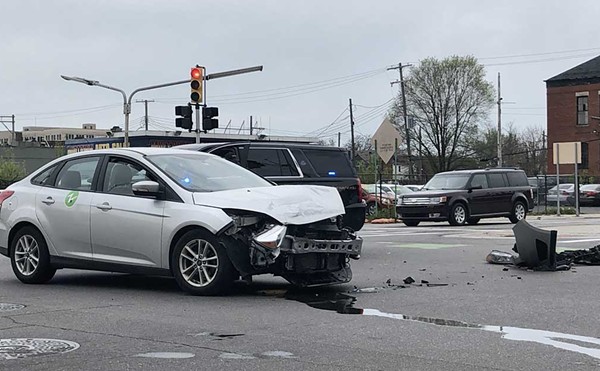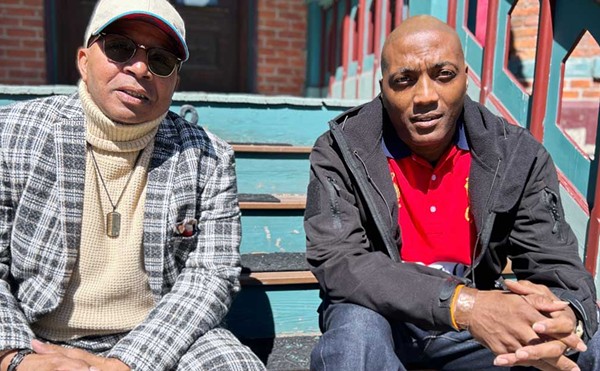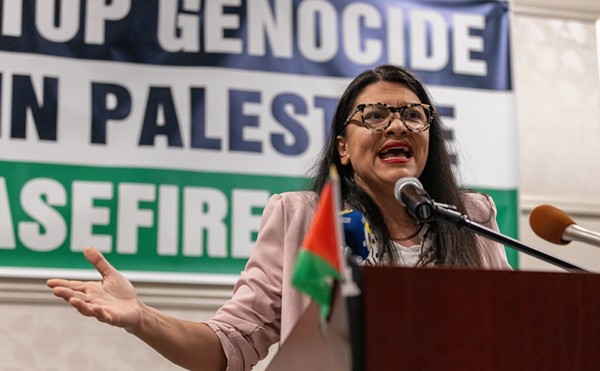Maggie Wider rocks back in her chair, avoiding Amber's gaze from across the table in the school library.
"I don't understand why she's making such a big deal out of it," says Wider. "It was just a friggin' seat at an assembly."
Amber Karam, a Troy High School senior, fingers a beige folder nervously, while Maggie gives her side of the story to the other teens gathered around. Karam leans forward. It's time for her to speak her piece.
"Even if she was going to sit there, she didn't have to chuck my things on the floor! That's not cool."
The girls aren't really fighting. They are demonstrating the arguments they sometimes hear as peer mediators at Troy High. The two girls helped train other students as mediators at the high school last week.
Troy High's peer mediation program is one of the nation's largest, involving about 150 of the school's more than 2,000 students. Nearing the end of a year in which there have been several high-profile school shootings, including the murder-suicide in Littleton, Colo., peer mediation programs such as the one at Troy High have been getting more attention than ever. The Troy program has been featured in newspaper and magazine articles, and on television and radio.
"Now, everybody wants to do this," says Gail Yax, co-founder of the program who runs it with the help of another teacher, Joe Moceri. "I don't want to say they have to do it. But people are looking at it more seriously."
Right after Columbine, John Bancroft, who helped start Troy High's peer mediation program about six years ago, testified before Congress along with various other experts on youth violence. While much of the testimony was philosophical, Bancroft offered peer mediation as a proven way of avoiding violence.
"We were the only ones saying 'We're doing this. This works. Please do this,'" he says.
Bancroft, since retired, has accepted requests to talk about peer mediation at various schools.
Before peer mediation came to Troy High, Bancroft says, there were a lot more fights at school. The advisers say their program's success in stemming violence has a lot to do with inclusion. Peer mediators and advisers say they try to draw other student mediators from every social clique — athletes, student government kids, goths, skateboarders, kids from various ethnic groups and gay and lesbian students. This kind of broad representation, Yax explains, helps peer mediators watch over more students while at the same time creating widespread peer pressure for peace.
"You wouldn't think there's a high school where it isn't cool to fight," Yax says.
Karam, 17, says, "We want to get every group in our group, so they can learn the process and teach their friends."
Peer mediators say they often hear petty arguments, such as Karam and Wider's role-playing tangle over the student assembly seat. However, they also encounter more serious situations involving talk of violence, suicide, racial or sexual harassment, and alcohol or drug abuse. Peer mediators say they are taught when counselors or authorities should be notified.
Seventeen-year-old peer mediator Mitch Harris says the Columbine incident was an eye-opener for him and other students. "It could happen anywhere, but people feel it's less likely to happen here because of our peer mediation program," he says. Harris says hundreds of kids apply each year to be mediators because "it's the cool thing to do." At the same time Troy High was training new mediators, Oakland Schools had a peer mediation expert from the Community Boards Program for Conflict Resolution in San Francisco helping to train representatives from several schools.
The community-based organization, which has been working on school violence prevention since 1982, supplies the peer mediation model for several schools in Michigan and other states.
Community Boards spokesman Jim Garrison says although peer mediation is often dubbed "touchy-feelie" by conservatives who prefer the "razor wire" approach — metal detectors, officers patrolling schools with guns — having students solve their problems among each other works.
"You're not being told what to do, you're not being talked down to," he says. "We don't recommend peer mediation for kids below the third grade, but kids who are third grade and above really can learn how to solve problems. They're learning not only how to talk to each other but how to help others without getting emotionally involved."
Garrison says peer mediation programs abound now that federal and state governments are pouring hundreds of millions of dollars into school violence prevention. The nonprofit Common Ground Sanctuary also uses the Community Boards peer mediation model at Franklin Elementary School in Pontiac. The program is funded by a grant from the Oakland County Office of Substance Abuse.
Troy High's program was modeled after a program by the Cleveland Marshall School of Law in Cleveland and has evolved to meet the school's needs, Bancroft says.
For there to be a mediation at Troy High, feuding students must agree to sit down with their peers, usually in what is called the "peer mediation room," and try to work things out. Mediators encourage both parties to tell their stories and to listen to each other. The opposing parties often come up with their own written agreement, which they then sign, says Yax. Sometimes the agreement is to stay apart. Other times, mediators say, the parties leave seeming like friends.
"It's been one of the best things I've ever done," says Zaynab Salman, another Troy High senior. "When I first came to Troy High, things would happen and if it didn't affect me, I didn't care. Once I got involved in peer mediation, I realized other kids were having the same problems I was, and problems I hadn't even thought of. You just see everything with so much more of an open mind."
Bancroft says it is important to remember that kids who cause trouble usually just want to be a part of something. The students who shot up their school in Colorado have been characterized as feeling alienated. Bancroft says peer mediation facilitates an atmosphere in which kids communicate and feel closer to each other.
"It scares me sometimes how afraid we are of these kids," he says. "If we were half as afraid of kids feeling alienated as we are kids being violent then we wouldn't have so many kids walking around feeling alienated."
The group's motto is a quote by Martin Luther King: "Violence is the language of the unheard."
As Bancroft puts it: "We're listening."





